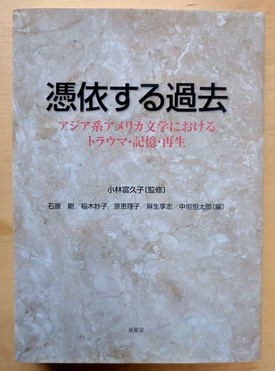The novel "No-No Boy" is a work of American literature written in English by Japanese-American author John Okada, but it has been discussed by experts in various fields beyond literature. In Japan, the world of this novel has been examined from literary, sociological and psychological approaches.
In literature, it seems to have been often discussed as a research subject under the category of "Japanese American literature" or "Asian American literature." In recent years, "No-No Boy" has been featured alongside various works of Asian American literature in "The Haunted Past: Trauma, Memory, and Regeneration in Asian American Literature" (edited by Kobayashi Fukuko, Kinseido), published in 2014.
This book was compiled by Professor Kobayashi Fumiko (at the time) of Waseda University as a commemorative collection of essays upon her retirement from the university, and it approaches Asian American literature from the perspective of "trauma." The impetus for this was the Great East Japan Earthquake of 2011. The book argues that the importance of understanding and conveying traumatic memories from disasters is also relevant to the history of Asian Americans, which is inseparable from war and conflict.
In his introduction, Kobayashi quoted a passage from Exploring Trauma edited by Cathy Caruth: "For victims of real-life tragic events, trauma leaves not only scars from the event itself, but also a 'double wound' that comes from the difficulty of putting the memory of that event into words and putting it into words for others. Furthermore, in cases where these scars happen to fall on an entire ethnic group, they do not remain with the individuals involved, but are passed down collectively among the ethnic group from generation to generation." He thus alluded to the relationship between trauma and the social and historical background that Asian American writers carry.
The collection contains 21 essays that examine Asian American literature from the perspective of trauma, categorized into four themes: "War," "Race," "Gender/Sexuality," and "Migration/Border Crossing."
Among these, Goto Kazumi (part-time lecturer at Waseda University) contributed an article on John Okada's "No-No Boy" titled "The illness of being a No-No Boy - the desire to gaze at the body." Kobayashi explains, "Using Lacanian theory and other sources, it is clear that Ichiro is an ambiguous existence that allows the Japanese people around him to establish themselves as Americans, but at the same time causes anxiety."
The subject of criticism since the 1970s
Going back nearly 40 years to 1977, the first Japanese article on "No-No Boy" appeared in that year. Shoji Yagasaki, who taught at Heian Jogakuin Junior College, wrote an article titled "Japanese Americans and Literature: John Okada and Lawson F. Inada" in the journal of the college (8, 23-30, 1977).
This Mr. Yagasaki is actually the real name of Mr. Yo Nakayama, who first translated "No-No Boy." The translation was published by Shobunsha in 1979, so this paper was written two years before that.
Yagasaki focused on the characteristics of Japanese Americans in America, the situation they found themselves in, and the changes in their own consciousness that accompanied social changes, such as the emergence of awareness of who they are and what their culture is.
With this in mind, in this essay he examines two cultural achievements of Japanese Americans, one of which is John Okada's novel "No-No Boy," and the other is the third-generation Japanese poet Lawson Fusao Inada.
This is a Beat novel.
Regarding "No No Boy," Mr. Yagasaki states the main points of the novel and then says the following.
I believe this novel was the first Beat novel written by a Japanese American. In many ways, it reminds me of Jack Kerawak's On the Road, a representative work of the Beatniks, a young American literary movement in the 1950s. The inner qualities of the phenomenon of withdrawal from society were exactly the psychological dilemma of American youth at that time. Paul Goodman's Growing Up Absurd (1960) goes into detail about this social background and inevitability. Just as Beat works were rejected by average white society, I think I can vaguely understand why this novel was rejected and disliked by those who were working enthusiastically to reintegrate Japanese Americans into white society, which was then recovering.
He continues:
After reading this novel, I wanted to introduce it to the world, or even felt a kind of obligation to do so. With this novel, John Okada may have further strengthened the psychological conflict that is latent in Japanese Americans.
It is clear that he has a great deal of passion and emotion. It is precisely because of this that Mr. Yagasaki (Yoshi Nakayama) was able to volunteer as a translator as a pioneer and bring this work to Japanese readers.
© 2017 Ryusuke Kawai







